Jana al-Issa | Hassan Ibrahim | Muhammed Fansa | Khaled al-Jeratli
The acts of war and the damage to infrastructure over a period of a decade have given way to searching for alternative options to those that have become clear with time that there is no hope of returning them to the way they were, in light of the absence of electricity and its poor access to various regions in Syria, after years of the start of the Syrian revolution in 2011.
The most important indications of impotence came when the president of the Syrian regime, Bashar al-Assad, admitted in his last interview with the Russian RT channel, on 9 June, during his response to a question related to the “deterioration of living conditions” of the Syrian citizen, considering that “the main obstacle is electricity,” promising that conditions would improve, but added, “We should not get our hopes up.”
The absence of electricity had a clear impact on the various sectors of production, amid the lack of alternatives to generate electricity for people and institutions as a result of material costs or the inability to rely on alternative energies as a source of electricity in Syria, according to its geographical location and the nature of its climate.
As an option that seemed to be one of the best alternative energy sources in Syria, reinforced by the absence of fuel, the spread of solar panels began in most regions, respectively, years ago, amid “government” support and adoption of this trend.
The use of solar energy spreads from northwestern Syria, which started relying on solar power around 2016, passing through areas in the north-east, ending with the areas under the control of the Syrian regime, which directed a clear trend to generate electricity through them, not only in large industrial facilities but even in homes.
In this lengthy article, Enab Baladi discusses the reasons that prompted the residents of Syria to rely on alternative energies to use electricity and the extent to which they are willing to do so, despite the many difficulties they may face as a result.
It also sheds light, by talking with experts and specialists, on the far future of the possibility of Syria’s dependence on alternative energies to secure electricity in terms of its geographical location and the technologies that are able to secure it economically, in addition to the obstacles that prevent this.
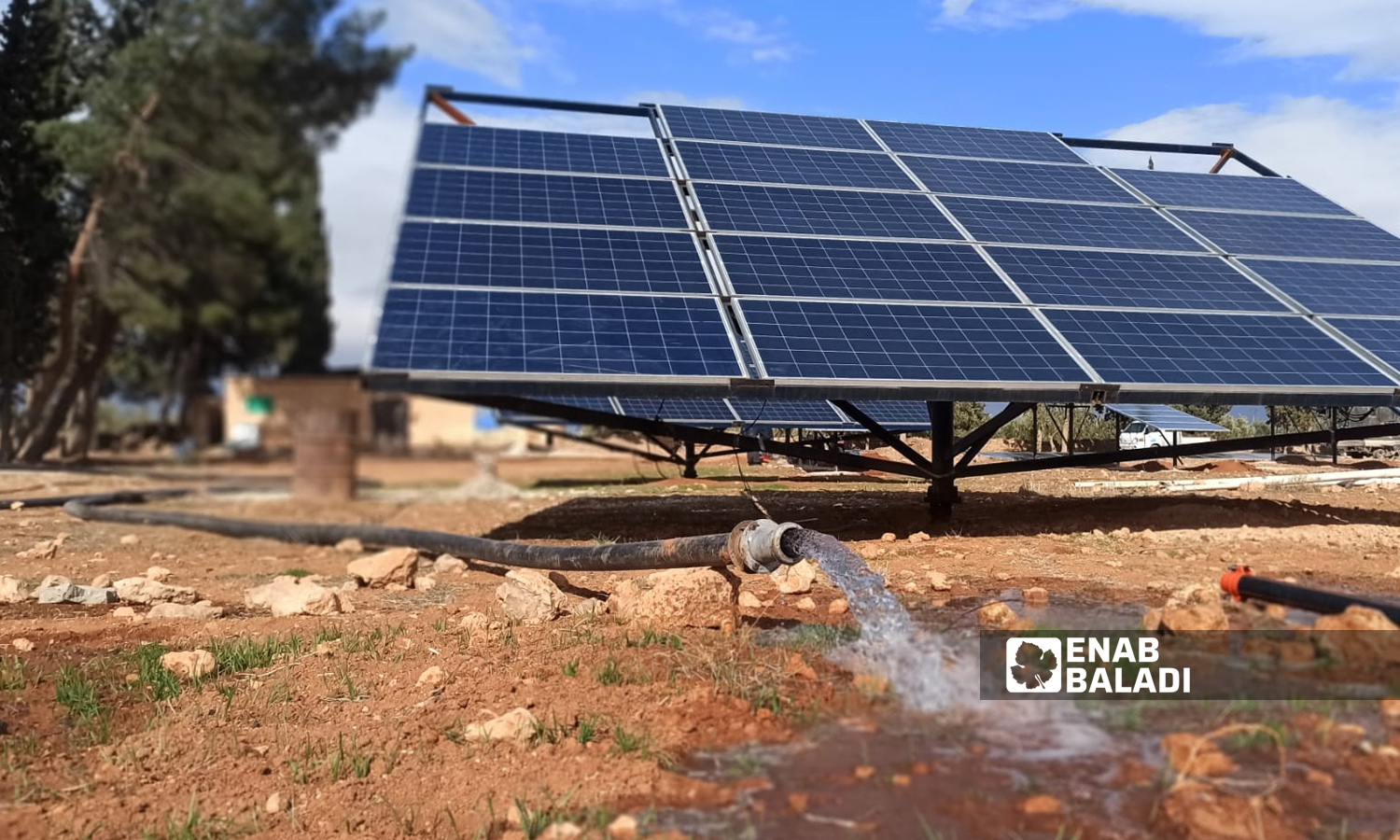
Solar panels in a farmland in the Qabasin town in the eastern countryside of Aleppo – 9 June 2022 (Enab Baladi / Siraj Mohammad)
Alternatives
The frequent rise in fuel prices and the difficulty of obtaining it at times, with the different areas of influence and control over the Syrian territory, and the continuous power cuts with the increase in the number of rationing hours have pushed Syrians to search for alternatives to secure electricity as one of the basics of daily life.
Amid the inability of the de facto governments in the various areas of control to solve the electricity problem, alternative energy generated through solar panels seemed a possible option to solve the problem, but this option collides with high costs beyond the ability of citizens with limited income, amid economic and living crises that they mainly suffer.
According to an opinion poll conducted by Enab Baladi, a number of Syrians residing in various governorates considered that alternative energy through solar panels is a better option than losing electricity despite its high costs and regardless of the controlling parties.
Residents of regime-controlled areas confirmed that the frequent and continuous power cuts prompted them to search for alternative solutions, but the high fuel prices made solar panels a suitable alternative, despite the high prices for their installation, as the price of a liter of diesel reaches about 4,500 Syrian pounds, and the price of a liter of gasoline is reduced to about 6000 pounds on the black market, the opinion poll shows.
Enab Baladi’s correspondent in Daraa governorate confirmed that the southern region witnessed a great demand for the use of solar energy by farmers, especially with the aim of operating wells and securing agricultural requirements.
In addition to some workers in the trade field, who resorted to installing solar panels instead of operating diesel generators to provide cooling or even to operate some small workshops such as sewing shops or food stores.
Farmers in Daraa consider that the solar panels have a relatively high financial cost, but they are paid once, and therefore they are cheaper than working with electricity generators that depend on fuel.
Regime-controlled areas have suffered from severe electricity rationing during the past two years, amounting to about five and a half hours of power outages compared to half an hour of power.
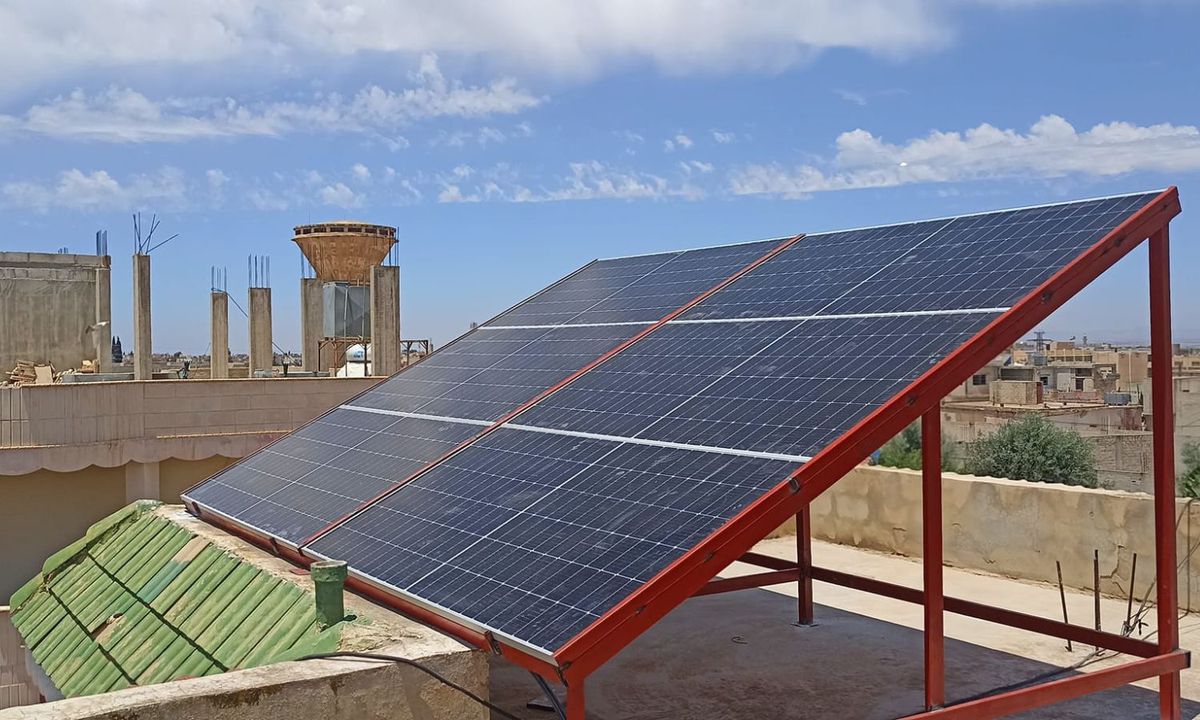
Solar panels installed on the roof of a building in Daraa governorate – 5 June 2022 (Solar energy group in Syria and its prices / Facebook)
Fuel prices, power cuts in Idlib
The areas under the control of the Syrian Salvation Government (SSG), which include Idlib city and part of the western countryside of Aleppo, Latakia countryside, and al-Ghab Plain, northwest of Hama, witnessed a decline in the return of electricity starting in 2011, and things gradually deteriorated, until the electricity supply stopped at the end of 2015. As well as the destruction of the infrastructure of the energy sector.
Many residents in the SSG’s areas resorted to using solar energy panels, despite their high cost, due to the high costs of obtaining electricity, whether from generator owners who delivered subscriptions to the people or from electricity companies operating in the area, which became active after the region went out of the control of the Syrian regime, in addition to the frequent power cuttings.
According to what the technical expert in the work of solar panels, Abdulnasser Diab, told Enab Baladi, solar energy has become an alternative solution and one of the basics of life and livelihood for the population in Idlib. Reliance on solar panels is not limited to a specific group or segment of people, such as industrialists and dealers in this region.
Diab added that there is a disparity in solar energy systems, allowing low-income people to buy them.
The technician says that despite the high installation cost, it is paid once, and therefore it is cheaper in the long run than relying on fuel, whose price increases more than once per month, so it has become a requirement to deliver electricity even to homes.
With somewhat greater use by industrialists and traders of the panels, some farmers in these areas also depend on the use of solar panels in the process of extracting water from wells and irrigating their crops due to the high prices of diesel and its lack of permanent availability, and it’s being less expensive compared to fuel prices.
The Watad Petroleum Company, which operates in the areas of influence of the Salvation government in northwestern Syria, raised on 31 May the prices of fuels and oil derivatives to unprecedented levels in Idlib governorate, justifying this by the rise in global oil prices.
The price of a liter of high-quality imported gasoline reached a dollar and 367 US cents, the gas cylinder price reached 13 dollars and 13 cents, the price of European diesel reached 952 cents, and that of the improved type 676 cents, and the price of refined diesel 572 cents.
Similar situation in Aleppo countryside
The areas of the northern countryside of Aleppo were systematically destroyed in vital sectors and basic facilities during the battles against the regime forces and the Islamic State group, and later against the US-backed Syrian Democratic Forces (SDF). Living conditions changed, and people were forced to rely on primitive ways to generate electricity, such as generators and car batteries, to light homes and shops during certain hours of the day.
The local councils in the areas of Aleppo countryside under the control of Turkey were able to secure electricity and end the “amperes” subscription phase that existed after the area got out of the control of the Syrian regime, and with the damage to the sector’s infrastructure, by contracting with two companies, “AK Energy” and “STE Energy,” to import electricity from Turkey.
But after three years of this experiment, which was punctuated by many criticisms of the policy of these companies, the last of which was in early June, when demonstrations took place for the people in the cities of Azaz, al-Bab, Mare’, and others, complaining about the high price of kilowatts and the unjustified power cuts, which indicates that the electricity situation still suffers from problems that these companies do not have solutions to, which negatively affect people’s lives.
Residents of the northern countryside of Aleppo, interviewed by Enab Baladi, considered that the instability of the electricity sector made solar panels a household necessity in recent years, as their use is not limited to the commercial sector only.
One of the displaced people of Eastern Ghouta, Tariq Subhi, 30, who lives in the city of al-Bab in the eastern countryside of Aleppo, told Enab Baladi that the use of solar panels came because the electricity company operating in the area raised the prices of electricity, as the prices rose from 0.85 Turkish kuruş to 2.2 Turkish liras per kilowatt, with the potential to rise to 4.5 Turkish liras, with power cuts off for hours.
Hamza Mohammad, one of the workers installing solar panels in the city of al-Bab, told Enab Baladi that the high electricity prices prompted people to use solar energy.
He added that their use is not limited to a specific category, as most of the users of energy panels in these areas are industrialists, traders, farmers, and large stakeholders that need stable and uninterrupted electricity, but solar panels have started to be used in homes more.
Mohammad Rajab, a panel installer and owner of the Energy World center in the city of al-Bab, explained to Enab Baladi that many farmers tend to use solar energy for irrigation, as it is less costly than drawing water using diesel-fueled machines, and it also requires less maintenance.

Solar panels in a house in the town of Qabasin in the eastern countryside of Aleppo – 9 June 2022 (Enab Baladi / Siraj Mohammad)
Power situation in northeastern Syria
Northeastern Syria, which is mostly under the control of the Autonomous Administration, is witnessing the spread of solar energy systems, like most Syrian regions, but they seem to be limited in the homes and facilities of families living in a good economic situation, according to what Enab Baladi monitored.
Among the reasons for its spread in Raqqa governorate, in particular, are the low water levels in the Euphrates River, the frequent breakdowns of generators, and the high price of one ampere, which has reached about 2000 Syrian pounds. (ampere is the name used by locals to refer to the subscription to electric generators)
Ayman al-Ali, 34, a dealer of solar panels and alternative energy systems in Raqqa, said that the residents’ desire to install energy systems is due to the sustainability of their electricity production, their independence from the public network, and the lack of breakdowns, which may be non-existent if the panels were installed in a correct way.
He pointed out that the installation of energy panels is in demand, but it is somewhat slow due to the high costs.
According to what Enab Baladi’s correspondent monitored in Raqqa, used panels from European sources are spread in the city, with poor quality and low operating efficiency, but their prices are acceptable, which has increased people’s demand for them.
The al-Hasakah governorate is also witnessing a demand for it, despite the existence of networks and facilities for the generation of electric power, including the al-Suwaidyia generation facility, which faces frequent technical failures, and the lack of water supply from the Turkish side, which does not exceed 40 percent of Syria’s regional share of the waters of the Euphrates River.
This caused a decrease in electric power, according to what was announced by the Office of Energy and Communications for the Jazira region on 5 June.
In a statement, the office stated that all the electrical energy available in the Jazira region is currently dedicated to operating vital strategic facilities such as water wells, mills, and bakeries until the technical problems in the al-Suwaidyia generation facility are overcome.
The Office of Energy and Communications repeatedly announces the disruption of electricity networks and lines, and the high tension in the area on an almost daily basis, as a result of being bombed by the Turkey-backed Syrian National Army (SNA).
Government encouragement
The Syrian Interim Government (SIG), which controls areas of rural Aleppo, issued a decision last May, excluding solar panels from customs duties at all crossings for a period of three months, until 31 July.
Abdul Hakim al-Masri, Minister of Economy in the SIG, explained in an interview with Enab Baladi that the decision was issued to support the solar energy sector, especially with the rise in electricity prices and the people’s recent repeated complaints from electricity companies in the region.
Al-Masri said that solar energy is more abundant, and it is clean and alternative energy, adding that the Interim government has endeavored to complete the project of extending electricity through solar energy, supplying it to people, unifying the price in a low and subsidized manner, and getting rid of the electricity crisis.
Supporting solar energy is a nucleus for developing investments in the region and the activity of industrial cities, according to the Minister of Economy, who indicated that investment in the region requires that the cost of electricity is appropriate and that the Interim Government will work to implement and support solar energy projects, until the creation of thermal power plants.
In the regime-controlled areas, there were general government calls to invest in the field of alternative energies, but the promotion and clear calls to import its equipment began more widely after the head of the Syrian regime, Bashar al-Assad’s inauguration speech after “winning” the presidential elections in May 2021.
At the time, he promised to work to encourage investment in alternative energy and support it through policies or legislation, aiming to launch power generation projects by the private or public sector or in cooperation between them.
In October 2021, al-Assad created the Fund to Support the Use of Renewable Energies, followed by the regime’s approval to grant the Ministry of Electricity a financial advance of 10 billion Syrian pounds for the benefit of the fund, with the aim of “raising energy efficiency so that citizens can benefit from the fund’s services.” So far, the fund has not issued any decision to help citizens secure the solar energy system.

Solar panels in a farmland in the Qabasin town in the eastern countryside of Aleppo – 9 June 2022 (Enab Baladi / Siraj Mohammad)
High costs for low-income people
The solar energy system needs panels, wires, batteries, and a device responsible for the process of regulating electricity and managing currents, known as an “inverter,” which increases the cost of adopting solar panels as an alternative to electricity.
The cost of solar systems for most domestic uses, outside the framework of production projects, ranges between 4 million and 14 million Syrian pounds, according to what Enab Baladi monitored from the websites of companies that install power systems in regime-controlled areas.
“We have not seen electricity in the winter, nor will we see it in the summer. Do you know what it means for one’s ambition to be reduced to having electricity for an hour straight?”
With words mixed with despair and disappointment and calls and hope for a change in the “bad” electricity situation in the city of Latakia in northwestern Syria, Lamis, 31, under a pseudonym for security reasons, waits from five to six hours a day until the electric current reaches her home for half an hour in al-Awina neighborhood in the Latakia city.
Lamis told Enab Baladi that the problem of electricity is not a new one, as all the city’s neighborhoods suffer from the lack of electricity and power outages, despite promises that are not being fulfilled.
The outage duration is about five and a half hours, and in the evening, the electricity is available for half an hour, at an average of two hours in 24 hours.
Lamis, who lives with her husband, was unable to buy a single solar panel due to the lack of sufficient money. The price of a panel capable of charging a small battery and lighting a room is about 80,000 Syrian pounds, regardless of its quality, while the monthly salary of her husband, who is an employee in an agricultural establishment affiliated with the Syrian regime, is about 110,000 Syrian pounds.
Meanwhile, Saeed, 34, a resident of al-Awaina neighborhood who works in an accessories store, bought two small power panels to charge a battery and operate lighting only without providing for the basic needs of his family, consisting of his wife and two children, such as running a refrigerator or washing machine, according to what he told Enab Baladi.
Nabil, 36, a resident of the countryside of Daraa governorate, told Enab Baladi that operating an entire house on solar energy needs at least 12 million Syrian pounds, a budget that is difficult for most families to secure in light of the deteriorating economic conditions.
Nabil added, Enab Baladi withheld his full name for security reasons, and that operating a house entirely on solar energy has become a luxury, but most people’s concerns are securing a battery and charging it when electricity is available instead of buying a solar energy system to secure sustainable electricity.
For his part, Mohammad Alaiwi, 45, a teacher from the Qamishli countryside, told Enab Baladi that he “dreams” of installing a solar energy system for his house in the village where he lives because its prices are “out of reach” for him and it is not enough to buy even “half a solar panel.”
According to Alaiwi, there is no better alternative than solar energy in the countryside, which lacks generators that sell electricity in units of (amperes), as is the case in the city, and electricity reaches Alaiwi’s home only two hours a day, through the regular electricity network that is currently controlled by the Autonomous Administration.
Raqqa-based Saeed al-Darwish, 40, was forced to install a solar energy system, which costs about 1000 US dollars, to generate four amperes of electricity for his home after the repeated failure of the “ampere” generator and an increase in the hours of rationing in public electricity.
In the regime-held areas, the costs of installing a solar energy system are added to the need for a license to install the panels and to abide by specific conditions for approval after the Damascus Provincial Council asked citizens to review it to obtain a license to install solar panels with the aim of “determining heights.”
Nidal Hafez, Director of Services Departments in Damascus Governorate, said that a citizen who wants to install solar energy must submit a request to the governorate to organize its installation on the roofs of buildings of common ownership, and the Services Directorate determines the area in which he/she can install.
Can solar energy be relied upon in the future of Syria?
According to a study published in the Middle East Studies Center (MESC) in September 2021, the use of renewable energies declined even before the outbreak of the Syrian revolution.
The study, which was prepared by the Syrian researchers Sinan Hatahet and Karam Shaar, showed that the use of renewable energies decreased by 20 percent in the early 1990s, then decreased to 5 percent when the war began in Syria, and with the continued slowdown in the flow of water from Turkey, and the inability to reform, hydroelectric turbines, hydropower contributed 2 percent or more to the general electric supply in 2020.
The spread of reliance on alternative energies, amid a government push, raised questions about the possibility of future dependence on these energies in Syria as the main source that may be the only source of electricity production and the accompanying obstacles to achieving this.

Solar panels on the roof of a house in Hama city – 25 May 2022 (Solar energy group in Syria and its prices / Facebook)
Solar energy is the best alternative
Syrian professor in economics and director of research at the Operations and Policy Center (OPC), Karam Shaar, told Enab Baladi that alternative energy sources, in general, are water, wind, and sun. As for hydro energy that runs on hydro turbines, its contribution to the production of electricity in Syria has decreased since the nineties of the last century until today for several reasons, including the drop in the water level on the one hand and the lack of maintenance of turbines on the other.
Dr. Shaar stressed that the future of electricity generation through hydropower is in decline, as it is related to the water situation in Syria, which in turn is heading for the worst.
Regarding wind energy, which is the second source of energy, Syria is not considered one of the countries that have a sufficient amount of wind throughout the year to produce electricity, and therefore the solar energy situation is regarded as the best in it.
Shaar says that Syria is among the top 20 countries in the world in terms of the ability to generate electricity through solar energy, as it has many sunny days.
Iyad, the Syrian engineer specialized in renewable energies, refused to use his full name for security reasons and told Enab Baladi that Syria, as a geographical location, is considered one of the best climatic areas in terms of solar radiation throughout the year.
In addition to the somewhat moderate heat, compared to countries near the equator, which have very high heat rates in summer, which affects the performance of photovoltaic solar panels.
As for wind energy, the best areas for establishing wind farms are usually near the coasts and mountainous regions with air corridors, in addition to the fact that the construction of wind turbines requires companies and heavy equipment, which may not be easy to find in Syria, according to the engineer.
Full dependence not possible
Solar energy can be very useful for producing electricity if it is used in conjunction with a permanent power source that operates during periods when the production of electricity from solar energy is low (at night or during winter periods when the sun is absent), according to Dr. Karam Shaar.
However, in Syria, it suffers from many problems, the first of which is the lack of linkage between electricity coming from energies that run on fuel and gas and solar energy, and the life of the batteries is also one of its problems, as replacing the battery after it expires is more economically feasible than relying on it.
For his part, the engineer of renewable energies, Iyad, believes that relying on alternative energies is a sustainable solution for the future, as many solar panels have a lifespan of about 15 years.
But talking about a complete dependence on it alone is not currently possible due to the inability to dispense with gas and oil derivatives in power plants, which cover the needs of industrial areas and large loads, Iyad adds.
Alternative energy is currently relied upon as power generation stations supporting the electrical network, reducing dependence on other stations, and saving gas and oil consumption.
But this depends on a country’s plan to encourage and establish these stations. Denmark, for example, has more than 50 percent of the energy generated from alternative energy.
While the obstacles to future dependence on it in Syria are the lack of a stable electrical network, one of the most important reasons for the success of connecting alternative energies is the presence of a 24-hour electrical network.
Even if the electricity prices are high, the consumer can connect his solar system to the electric grid with what is known as “grid-related systems” and export energy to the network in the evening or on cloudy days.
This is done through a meter to calculate the energy produced between the consumer who owns the system and the electricity company, without relying on batteries to store energy, as in “off-grid systems.” The consumer needs batteries to store the energy generated by the panels, which costs him twice the price of the system connected to the network.
The engineer explained that this method “unfortunately” is not available in Syria, stressing that the lifespan of the existing batteries is estimated at about three years on average, in addition to the presence of a lot of poor-quality batteries in the market.
International support needed
In light of the current data, solar energy is considered, to this day, less economically feasible than unclean energy that runs on fuel and gas, and it is the best alternative, according to Dr. Shaar.
To support this sector and regulate the work of solar energy, the supporting countries must increase the value of their financial support in this sector, in particular, given the lack of hope in the ability of the active forces in the various regions of Syria to continuously generate electricity, Shaar added.
The engineer Iyad believes that relying on solar energy can be a permanent and sustainable option in the future, noting that people may currently face many problems in storing energy, but those who have installed solar panels to light a house or irrigate agricultural land and also operate workshops for a few hours will have a solar energy system operating for more than ten years if it was of a good type.
In the coming years and in the event of establishing new power plants and improving the electrical network, those who have a solar energy system will be ready to connect with the electrical network and decrease energy consumption without facing problems related to electricity bills, whatever they may be.
Enab Baladi’s correspondents in Daraa, Raqqa, and the Aleppo countryside contributed to this article.
if you think the article contain wrong information or you have additional details Send Correction
النسخة العربية من المقال
-
Follow us :












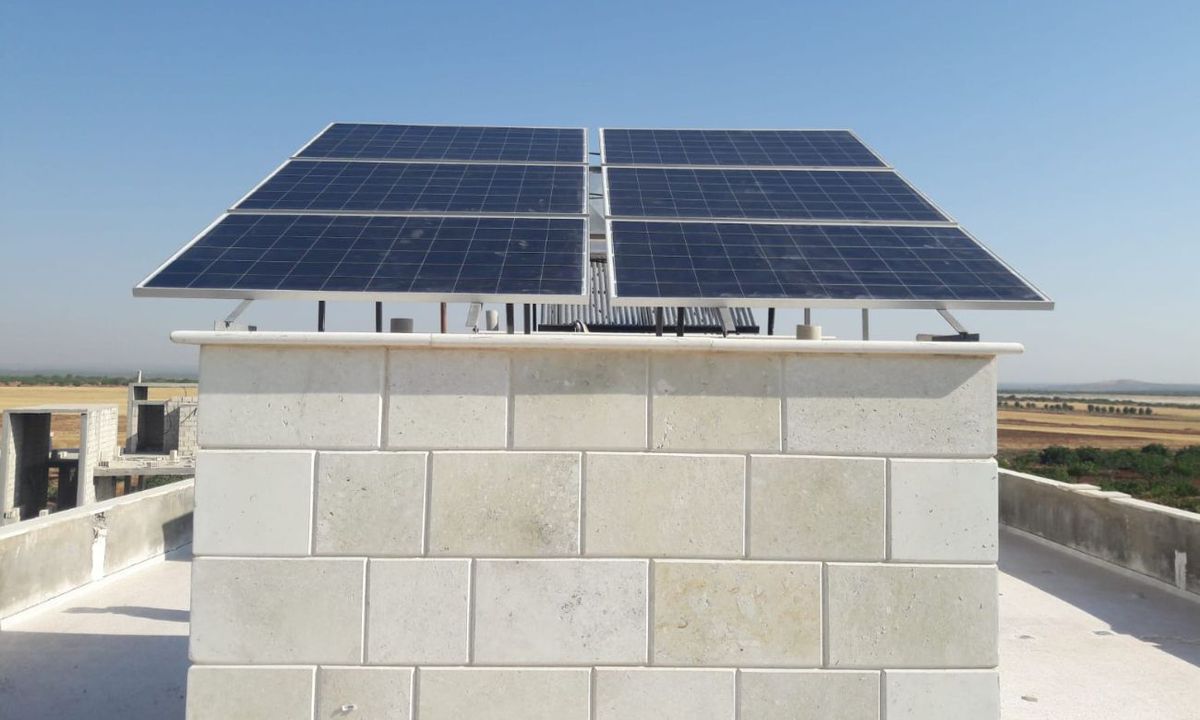
 Solar panels on the roof of a house in the Qabasin town in the eastern countryside of Aleppo - 9 June 2022 (Enab Baladi / Siraj Mohammad)
Solar panels on the roof of a house in the Qabasin town in the eastern countryside of Aleppo - 9 June 2022 (Enab Baladi / Siraj Mohammad)





 A
A
A
A
A
A
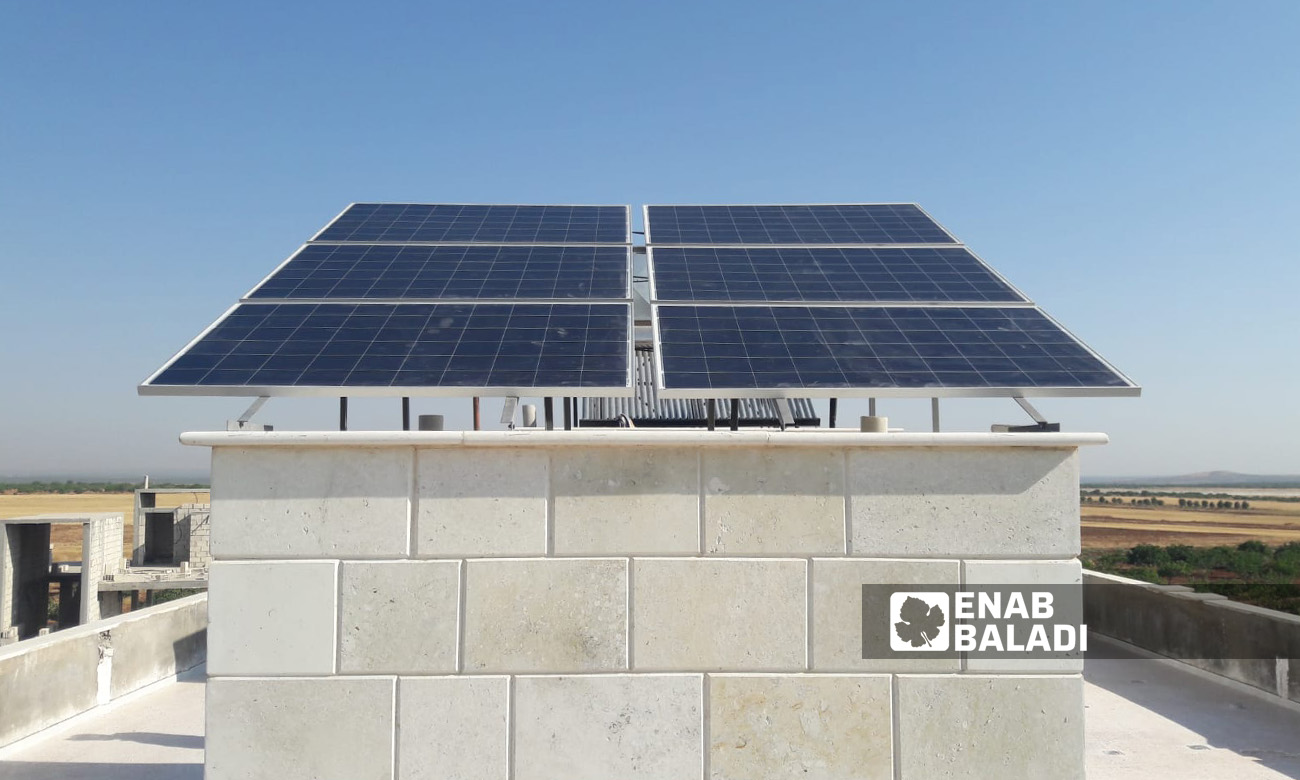
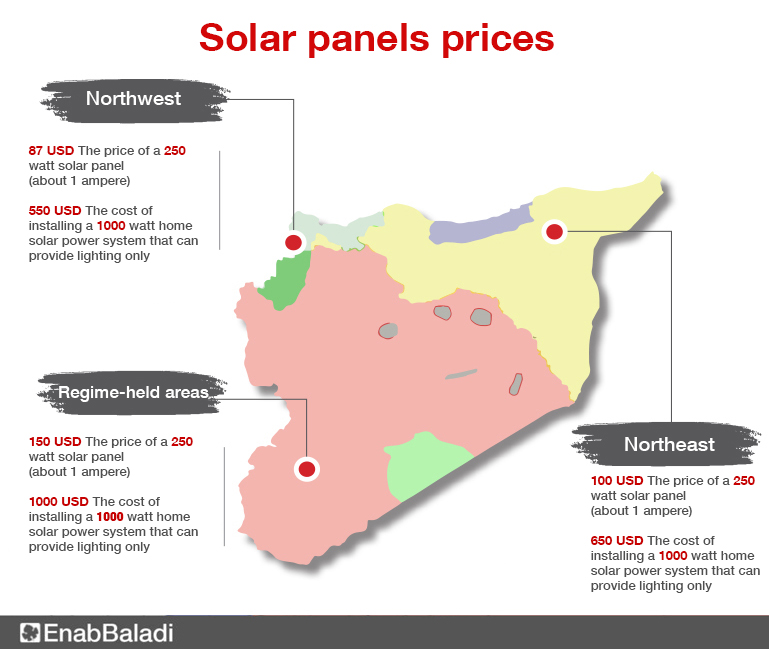







 More In-Depth
More In-Depth